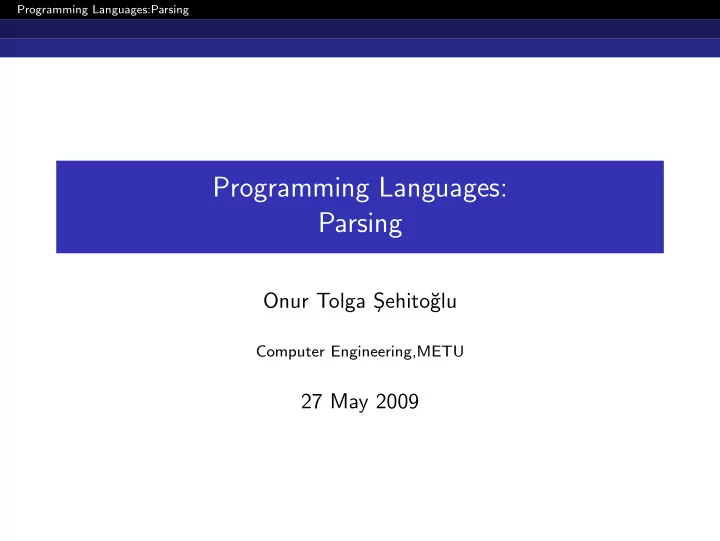

Programming Languages:Parsing Programming Languages: Parsing Onur Tolga S ¸ehito˘ glu Computer Engineering,METU 27 May 2009
Programming Languages:Parsing Outline 1 Parsing Top-down Parsing Recursive Descent Parser LL Parsers
Programming Languages:Parsing Parsing Parsing input result of the lexical analysis output parse tree or intermediate code Two types: Top-down Bottom-up
Programming Languages:Parsing Parsing Top-down Parsing Top-down Parsing Start from the starting non-terminal, apply grammar rules to reach the input sentence � assign � �→ a = � expr � �→ a = � expr � + � term � �→ a = � term � + � term � �→ a = � fact � + � term � �→ a = a + � term � �→ a = a + � term � ∗ � fact � �→ a = a + � fact � ∗ � fact � �→ a = a + b ∗ � fact � �→ a = a + b ∗ a �→ Simplest form gives leftmost derivation of a grammar processing input from left to right. Left recursion in grammar is a problem. Elimination of left recursion needed. Deterministic parsing: Look at input symbols to choose next rule to apply. recursive descent parsers, LL family parsers are top-down parsers
Programming Languages:Parsing Parsing Top-down Parsing Recursive Descent Parser typedef enum { ident , number , lparen , rparen , times , s l a s h , plus , minus } Symbol ; int accept ( Symbol s ) { if ( sym == s ) { next (); return 1; } return 0; } void f a c t o r (void) { if ( accept ( i d e n t )) ; else if ( accept ( number )) ; else if ( accept ( l p a r e n )) { e x p r e s s i o n (); expect ( rparen );} else { e r r o r ("factor:�syntax�error�at�", currsym ); next (); } } void term (void) { f a c t o r (); while ( accept ( times ) || accept ( s l a s h )) f a c t o r (); } void e x p r e s s i o n (void) { term (); while ( accept ( p l u s ) || accept ( minus )) term (); }
Programming Languages:Parsing Parsing Top-down Parsing Each non-terminal realized as a parsing function Parsing functions calls the right handside functions in sequence Rule choices are based on the current input symbol. accept checks a terminal and consumes if matches. Cannot handle direct or indirect left recursion. A function has to call itself before anything else. Hand coded, not flexible.
Programming Languages:Parsing Parsing Top-down Parsing LL Parsers First L is ‘left to right input processing’, second is ‘leftmost derivation’ Checks next N input symbols to decide on which rule to apply: LL( N ) parsing. For example LL(1) checks the next input symbol only. LL( N ) parsing table: A table for V × Σ N �→ R for expanding a nonterminal NT ∈ V , looking at this table and the next N input symbols, LL( N ) parser chooses the grammar rule r ∈ R to apply in the next step.
Programming Languages:Parsing Parsing Bottom-up Parsing Bottom-up Parsing Start from input sentence and merge parts of sentential form matching RHS of a rule into LHS at each step. Try to reach the starting non-terminal. reach the input sentence a = a + b ∗ a �→ a = � fact � + b ∗ a �→ a = � term � + b ∗ a �→ a = � expr � + b ∗ a �→ a = � expr � + � fact � ∗ a �→ a = � expr � + � term � ∗ a �→ a = � expr � + � term � ∗ � fact � �→ a = � expr � + � term � �→ a = � expr � �→ � assign � �→ Simplest form gives rightmost derivation of a grammar (in reverse) processing input from left to right. Shift-reduce parsers are bottom-up: shift: take a symbol from input and push to stack. reduce: match and pop a RHS from stack and reduce into LHS. Deterministic parsers LALR, SLR(1).
Recommend
More recommend